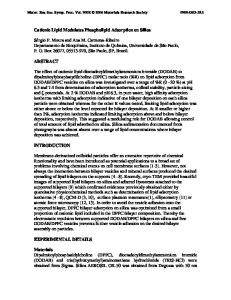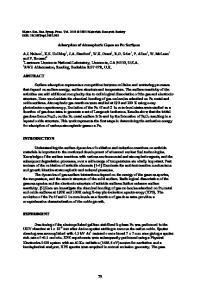Stable Adsorption of Lipid Vesicles on Modified Gold Surfaces
- PDF / 490,795 Bytes
- 6 Pages / 612 x 792 pts (letter) Page_size
- 69 Downloads / 282 Views
Stable Adsorption of Lipid Vesicles on Modified Gold Surfaces Stavroula Sofou and James L. Thomas Department of Chemical Engineering, Columbia University 500 W. 120th St. New York NY 10027 Abstract The use of vesicles as amplifiers in biosensors is receiving increasing attention. Because vesicles may entrap thousands of reporter molecules, strong signal amplification can be obtained if a small number of analytes can simply release the entrapped reporters. Surface immobilization of vesicles with sensitivities for different analytes could then provide for simultaneous amplified detection of a number of analytes on a single chip. To achieve this goal, vesicles must first be stably adsorbed to a surface, without rupture. We have varied vesicle composition and charge (phosphatidylcholine, phosphatidylcholine-phosphatidic acid at 4.6 molar ratio) and solution ionic strength, to study the adsorption of fluorescent vesicles to glass, gold, and gold modified with chemisorbed acetylcysteine. Surfaces were characterized with angle-resolved X-ray photoelectron spectroscopy (ARXPS), and vesicle integrity and behavior was studied using entrapped and lipophilic fluorescent markers either together or in separate experiments. Diffusion coefficients (by photobleaching recovery) and vesicle fusion (by energy transfer) were monitored using confocal fluorescence microscopy. Finally, as a "proof of principle", release of a self-quenching entrapped reporter dye (calcein) by the detergent Triton X-100 was followed in real time. Introduction Vesicles are self-assembling, closed shells formed by some amphiphiles in an aqueous environment. Those formed by the naturally occurring phospholipids are useful as biomembrane mimics, and have applications in separations and in sensing and amplification. In many applications, it is useful to anchor the phospholipid vesicle to the surface of a substrate, yet vesicle immobilization presents special difficulties. A vesicle, like a liquid droplet, will tend to spread on an adhesive substrate.This spreading will be opposed by a volume constraint – even though water can easily permeate lipid membranes, the presence of any salts or buffers will create osmotic opposition to water efflux. The net result is an increase in membrane tension, as well as high curvature at the line of vesicle contact. These forces favor disruption of the lipid vesicle, either through vesicle-vesicle fusion processes, or through outright vesicle rupture. Thus, stable anchorage of lipid vesicles to a planar solid substrate requires a precise tuning of the vesicle-substrate interactions so as to produce a weak attractive overall interaction. Gold surfaces are useful in a variety of biosensors, including plasmon resonance systems, quartz crystal resonators, and electronically addressable arrays. The behavior of lipid vesicles on gold surfaces is poorly characterized, but it is clear from photobleaching recovery mobility measurements that supported fluid lipid bilayers (such as those formed on glass) do not form on gold.[1] We report her
Data Loading...










